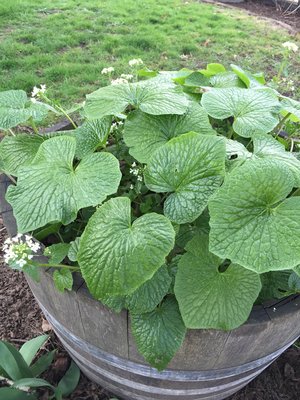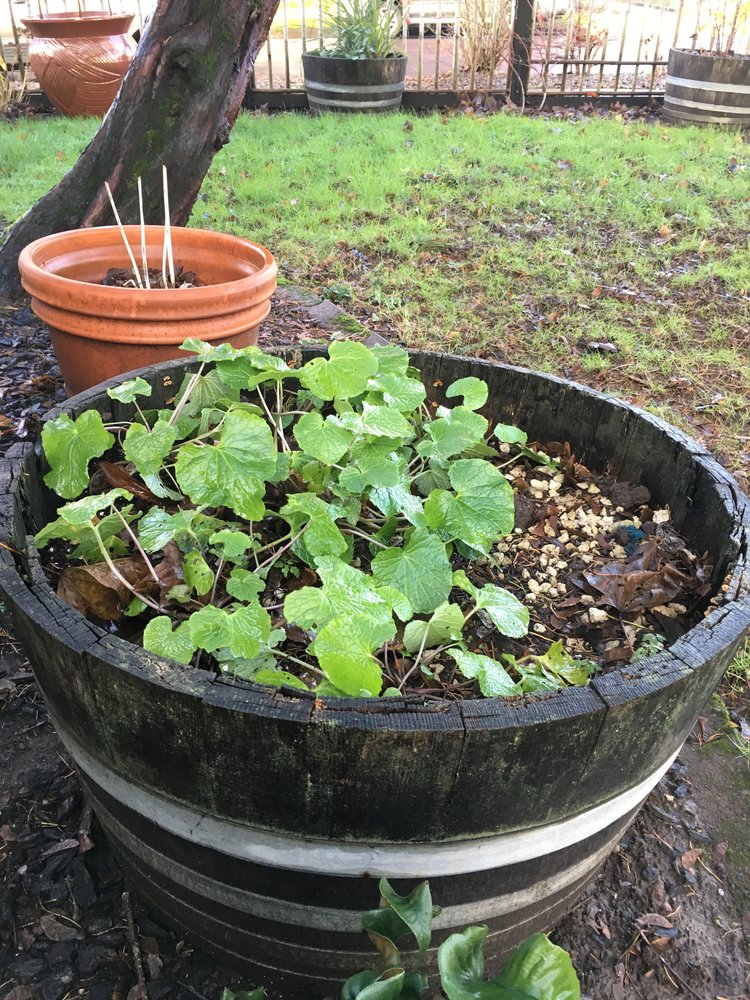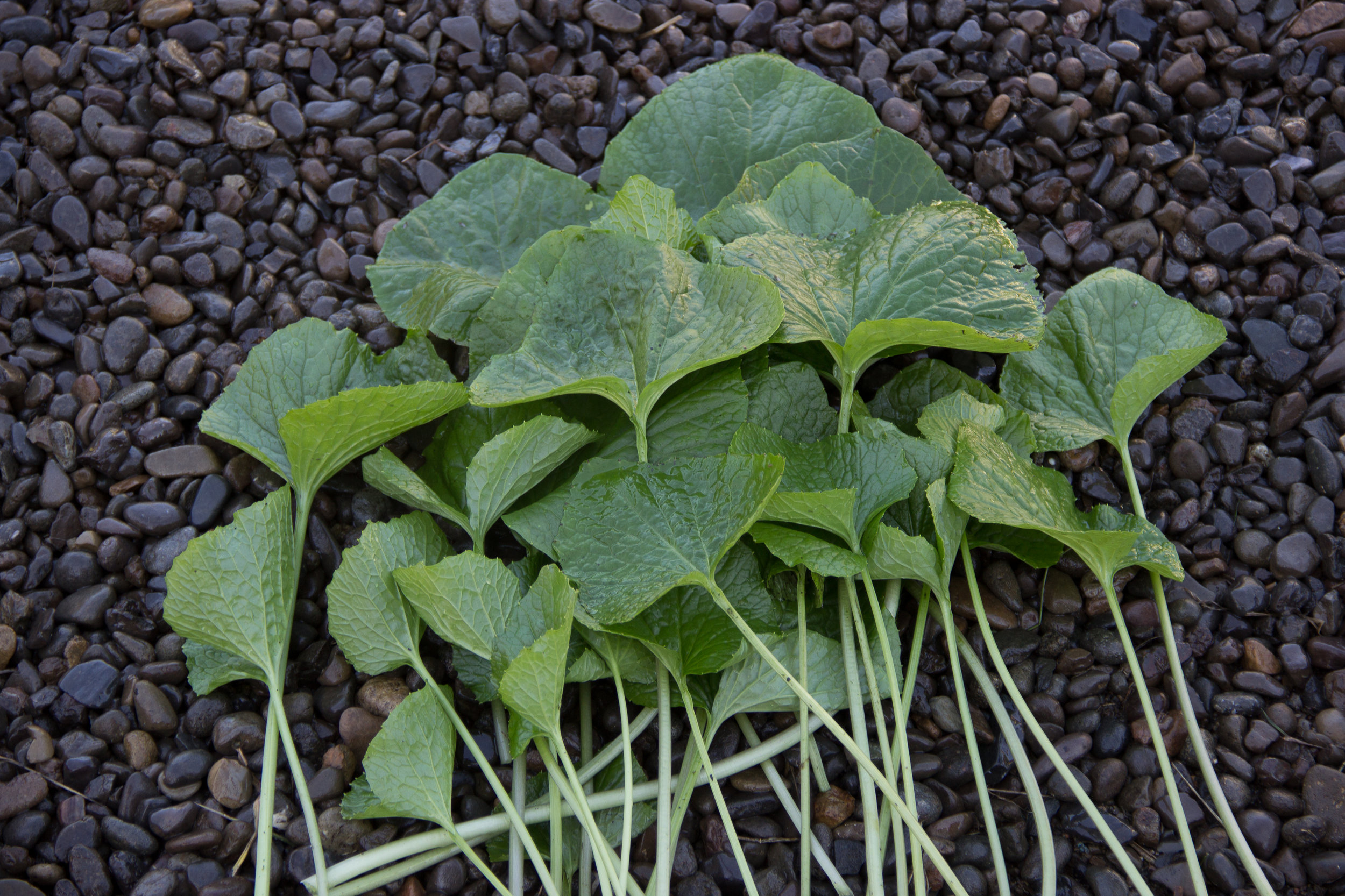FAQs - Growing Wasabi in your Backyard
For those of you growing wasabi in your backyard we have put together this handy FAQ document.
Shade or sun? Full shade. All year. Filtered sunlight is OK.
When to plant? Wasabi can be planted any time of year. It's not limited to spring planting. We favor spring or autumn planting which assures a wet winter establishment period and ready in time for tender April leaves and leaf stems for wasabi zuke.
What about transplant shock? Wasabi is quite resistant to this shock. The plants can be pulled out of the ground, the offshoots removed and everything replanted at any time. If, after reading these FAQs, believe you could improve your plants' conditions, feel free to remove them from the ground, put them back in the refrigerator for up to 2 weeks in a plastic bag with a damp paper towel inside, refine the growing conditions or location and replant.
The plants are bare root, how soon should they be planted? They can remain in the shipping bag for up to 3 weeks with no problem. Open the plastic bag to allow the plants to breathe and insert a damp paper towel. Plant them when the temperatures are lower and/or there is rain forecasted. It's better to wait to plant them when conditions are better than try to plant them in a hot or dry period.
Singular or grouped? You can purchase one plant, however Wasabi plants in a group form a leaf canopy that retains soil moisture and shades the central stalk. Plant them approximately 8 inches on center. The more plants there are the more successful they seem to be.
Is it cold tolerant? Yes. The garden plants at our home in Portland, Oregon experience lower temperatures than the farm plants at the Coast. Winter of 2016/2017 experienced multiple days below freezing and consecutive nights in the upper teens (see link here). 95% of the garden plants survived. The summer of 2017 was hot and dry and we realized more plant loss than in the winter. It seems that Wasabi has more cold tolerance than heat and dry tolerance. Stated differently, summertime is more of a danger than winter (this is of course a generality). We recommend keeping more of the leaf canopy in height of the summer to provide shade to the central stalk.
Does it spread? No. Not like horseradish or mint or strawberries. Wasabi propagates via offshoots that grow from the base of the plant. The offshoots don’t grow offshoots while it’s attached to the main plant/stalk. You can control the area of wasabi by pulling off the offshoots and replanting them in the area you want them to occupy.
When can the offshoots be removed? They can be removed and separated at any time of year although spring and fall seem to be the best times. Plant the offshoots about 8 inches apart. This allows the plants to form a leaf canopy.
How long do they live? At least up to 10 years. Most of our garden plants are 3-4 years old.
When is it harvested? Leaves and leaf stems are harvested at any time. Whenever the plants have enough leaves and stalks for whatever you want to do with them. The central stalk (rhizome) that is grated into paste will likely take two years to grow into the size you would want for a meal of 4-6 people. The leaves and leaf stems can be harvested about every 6-8 weeks (this is how long it will take the leaves to grow back) without negatively impacting the growth of the plant. The plant is a brassica and like kale, brussels sprouts etc. the leaves can be removed while this central stalk grows.
Planting Depth: Plant them only as deep as it takes to keep them upright. About 1/2 inch. If you are repotting your plant don’t plant them any deeper than they were in the original pot. Don't compact the soil to remove oxygen from the root zone. Wasabi prefers an oxygenated environment at the root zone. Keep the growing medium light and fluffy. Don't compress the planting area after planting.
What to plant in: We recommend a good potting soil. If your soil contains clay, amend with the following: coconut fiber, pumice, or gravel. Optimal is potting soil, coconut fiber and pumice at a 1:1:1 ratio. Wasabi prefers an oxygenated environment at the root zone. Keep the growing medium light and fluffy. Don't compress the planting area after planting.
Can they be planted inside? Yes, but don’t put it on the windowsill remember this is a shade plant. Bathrooms are good. Dark corners with no direct light are good. See "what to plant in" in this FAQ.
Would they be invasive in a stream? No, wasabi is a very slow growing plant. It won't compete for space or sunlight with other plants that likely grow faster than wasabi. (also reference
"Does it spread" and "How long before I can harvest")
Can they be planted in a stream? Yes. Though wasabi is happy on the stream banks and even slightly up the bank. It may not grow in the stream channel if the channel is too deep, it is not an aquatic plant. So, plant it on the sides of the stream with water moving through the soil.
How long before I can harvest: The central stalk (rhizome/ not root) is what is grated into a paste. It will take about two years in a garden to grow a good sized rhizome. But the leaves and leaf stems (as opposed to the central stalk) can be harvested about 15 times while the stalk grows. We recommend to harvest the leaves and leaf stems at most every 6 -8 weeks depending on how fast your plants are growing. We also recommend to harvest fewer leaves and leaf stems in the summer to allow a canopy to form which shades the central stalk and helps prevent it from drying out and retaining soil moisture.
Can the central stalk be cut to make paste and the plant still grow? No. The plant won’t regrow. The plant needs both the roots and the top of the rhizome to grow. Cutting off the top and replanting the top won’t work either: we tried. Additionally, cutting off the bottom to retrieve the stalk won’t work either. This doesn't work with carrots, and neither with wasabi. Enjoy the leaves and leaf stems while the stalk grows. Enjoy the flowers and the year-round greenery.
What's the best soil type and pH? Slightly acidic soil. Wasabi prefers acidic soil to as low as to 5.8pH. Planting under fir trees is ok but the tree roots can compact the soil, preventing the wasabi roots from growing and retarding canopy (leaf and leaf stem) growth. If you plant under fir trees, make a raised bed or dig out an enlarged area and replace the soil with the optimal amended type described in "What to plant in".
Why do the plants arrive bare root and not in pots? Shipping the plants bare root is easier on the plant and reduces the shipping weight.
Does it flower? Yes. The plants begin flowering about late January or early February and will flower until early to mid-May. The flowers are edible and can be tempura-fried or steeped into a tea or raw in a salad or cooked into soup.
Does it get bitter? No. The flavor doesn't change during the flowering cycle.
Does it bolt? No. Wasabi is a perennial plant that produces leaves year-round, it does not bolt and die off. The plant parts are edible and delicious through the flowering cycle. Each central stalk / rhizome will have undergone multiple flowering cycles before harvest.
Are there any pests? Wasabi is susceptible to some fungal pathogens. Also, aphids and slugs are animal pests. Wasabi grows like a banana plant and the leaves naturally die off over time if they aren’t harvested. Slugs seem to prefer the dying leaves. Leave these on for the slugs to eat and they’ll leave the center leaves alone; for the most part. If you have pest issues, you can use Safer Soap for aphids and a water/bleach solution for any fungal pathogens. Put 3-4 tablespoons of bleach in a gallon of water and soak the plants for 20 minutes. Rinse them in clean water and replant in fresh soil. You can trim off the leaves and leaf stems if they are pulling the plant over after replanting.
Does it have to grow in running water. No. Wasabi is not an aquatic plant. Wasabi does just fine in soil with the right conditions. Reference "Can they be planted in a stream".
How hot is it / is it as hot as restaurant wasabi? The leaves are like a radish leaf or arugula. The leaf stem is slightly hotter than that. Both lose their heat when cooked. The stalk is as hot as restaurant wasabi as long as it's grated to a fine paste. The finer the paste, the more heat and flavor is released from inside the cell walls of the plant. If it's shredded on a microplane or ginger grater, it is only slightly hot, not sweet and not as flavorful. (Note, most North American restaurant wasabi is horseradish and green food dye and stabilizers with little or no actual wasabi. Alas! Indeed, this is why we started this business, to bring fresh wasabi to more people to enjoy.)
How big do they get? Height: approximately 2-3 feet. Canopy: approximately 1.5 feet diameter. Stalk: range from 0.5 inches to 2 inches diameter. Leaves: up to 6 inches in diameter. Leaf stems: up to 1.5 feet in length.
Do they die back? No. But they do grow more slowly in the heat of the summer and during any frost.
Are they going to take over my yard or stream. No. Reference Would they be invasive in a stream?
Are they pet friendly? We've had one report that pet rabbits like eating the plant. The rabbit was perfectly healthy. We have also heard from people who have had their chickens and goats eat the plants. They are a bit spicy for deer. We know of no known negative reaction with any animal.
Will I kill the plant when harvesting the central stalk / rhizome. Yes. Reference
Can I grow them in pots. Yes. Reference Can they be planted inside?
How big of a pot? 1-2 gallon sized pot for a single plant. 5-gallon for three plants or larger for more. Reference When can the offshoots be removed?
What parts are edible: The entire plant including the central stalk (rhizome), leaves, leaf stems, flowers and roots.
Should I peel the stalk before grating? No. We offer a brush to remove any dirt, or excess vegetal matter.
How to eat the leaves or leaf stems? Generally, raw, steamed, sautéed or juiced. See our recipe page for more ideas.
How to divide the plant and offshoots. Pull the entire plant out of the ground. Wash off the roots in water either with a hose or soak in a water bucket. The plant is quite physically robust, this won't harm the plant. Gently pull the offshoots and associated roots away from the main plant. Replant to appropriate depth and spacing.
Planted under trees. Yes. Reference What's the best soil type and pH
How much water in the summer? As much as one would water lettuce. Assure no direct sunlight for any amount of time in summer.
UNHAPPY PLANT SYMPTONS AND LIKELY CONDITIONS
Leaf crinkle: likely aphids.
Yellow leaves on the side. With green leaves in center. This is natural. The leaves naturally die away.
Top/central leaves are yellow. Unhappy. Amend soil with "optimal" ratio or the soil is holding too much water.
Grow slow. Too dry, too wet, too hot or too cold.
Droopy leaves: too much sunlight
Light red stems: when young this is typical.
Dark red stems : The plant is unhappy. Likely too much water at the roots. Amend the soil and relocate to another shady spot.













